coolant level KIA CARENS RHD 2018 Owners Manual
[x] Cancel search | Manufacturer: KIA, Model Year: 2018, Model line: CARENS RHD, Model: KIA CARENS RHD 2018Pages: 723, PDF Size: 40.94 MB
Page 439 of 723
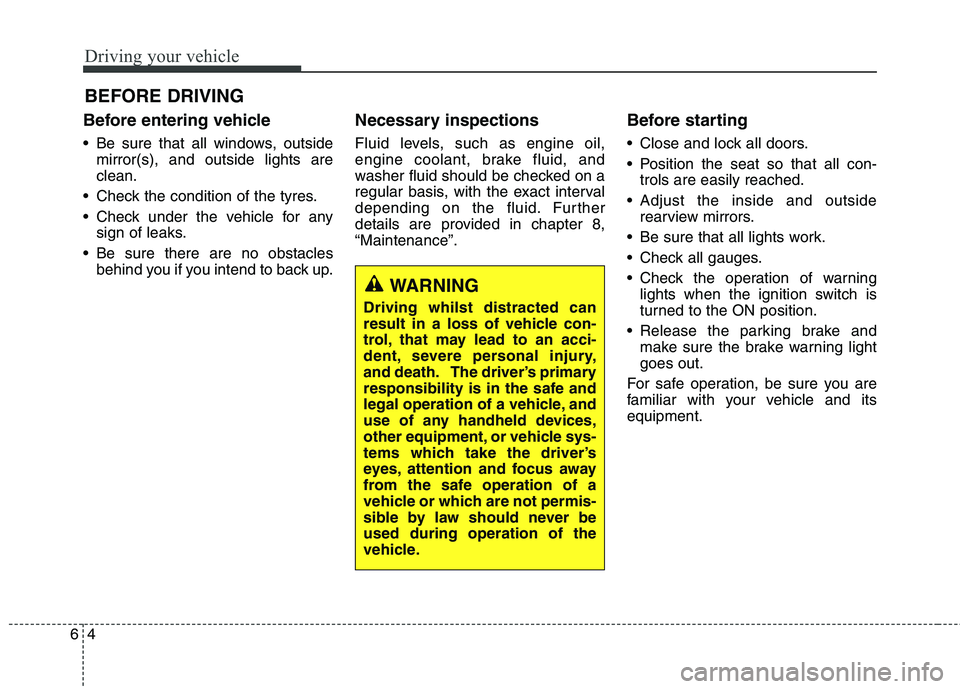
Driving your vehicle
4
6
Before entering vehicle
• Be sure that all windows, outside
mirror(s), and outside lights are clean.
Check the condition of the tyres.
Check under the vehicle for any sign of leaks.
Be sure there are no obstacles behind you if you intend to back up. Necessary inspections
Fluid levels, such as engine oil,
engine coolant, brake fluid, and
washer fluid should be checked on a
regular basis, with the exact interval
depending on the fluid. Further
details are provided in chapter 8,“Maintenance”.
Before starting
Close and lock all doors.
Position the seat so that all con-
trols are easily reached.
Adjust the inside and outside rearview mirrors.
Be sure that all lights work.
Check all gauges.
Check the operation of warning lights when the ignition switch is
turned to the ON position.
Release the parking brake and make sure the brake warning lightgoes out.
For safe operation, be sure you are
familiar with your vehicle and itsequipment.
BEFORE DRIVING
WARNING
Driving whilst distracted can
result in a loss of vehicle con-
trol, that may lead to an acci-
dent, severe personal injury,
and death. The driver’s primary
responsibility is in the safe and
legal operation of a vehicle, and
use of any handheld devices,
other equipment, or vehicle sys-
tems which take the driver’s
eyes, attention and focus away
from the safe operation of a
vehicle or which are not permis-
sible by law should never beused during operation of the
vehicle.
Page 533 of 723
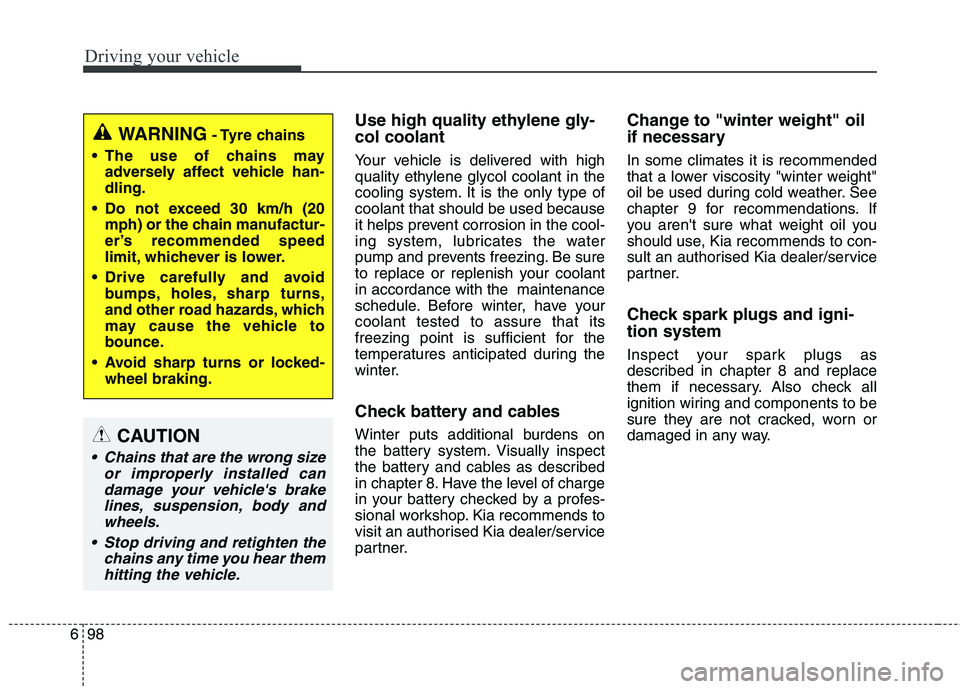
Driving your vehicle
98
6
Use high quality ethylene gly- col coolant
Your vehicle is delivered with high
quality ethylene glycol coolant in the
cooling system. It is the only type ofcoolant that should be used because
it helps prevent corrosion in the cool-
ing system, lubricates the water
pump and prevents freezing. Be sure
to replace or replenish your coolantin accordance with the maintenance
schedule. Before winter, have yourcoolant tested to assure that its
freezing point is sufficient for the
temperatures anticipated during the
winter.
Check battery and cables
Winter puts additional burdens on
the battery system. Visually inspect
the battery and cables as described
in chapter 8. Have the level of charge
in your battery checked by a profes-
sional workshop. Kia recommends to
visit an authorised Kia dealer/service
partner. Change to "winter weight" oil
if necessary In some climates it is recommended
that a lower viscosity "winter weight"
oil be used during cold weather. See
chapter 9 for recommendations. If
you aren't sure what weight oil you
should use, Kia recommends to con-
sult an authorised Kia dealer/service
partner.
Check spark plugs and igni- tion system
Inspect your spark plugs as
described in chapter 8 and replace
them if necessary. Also check all
ignition wiring and components to be
sure they are not cracked, worn or
damaged in any way.
CAUTION
Chains that are the wrong size
or improperly installed candamage your vehicle's brakelines, suspension, body andwheels.
Stop driving and retighten the chains any time you hear themhitting the vehicle.
WARNING - Tyre chains
The use of chains may adversely affect vehicle han- dling.
Do not exceed 30 km/h (20 mph) or the chain manufactur-
er’s recommended speed
limit, whichever is lower.
Drive carefully and avoid bumps, holes, sharp turns,
and other road hazards, which
may cause the vehicle to
bounce.
Avoid sharp turns or locked- wheel braking.
Page 558 of 723
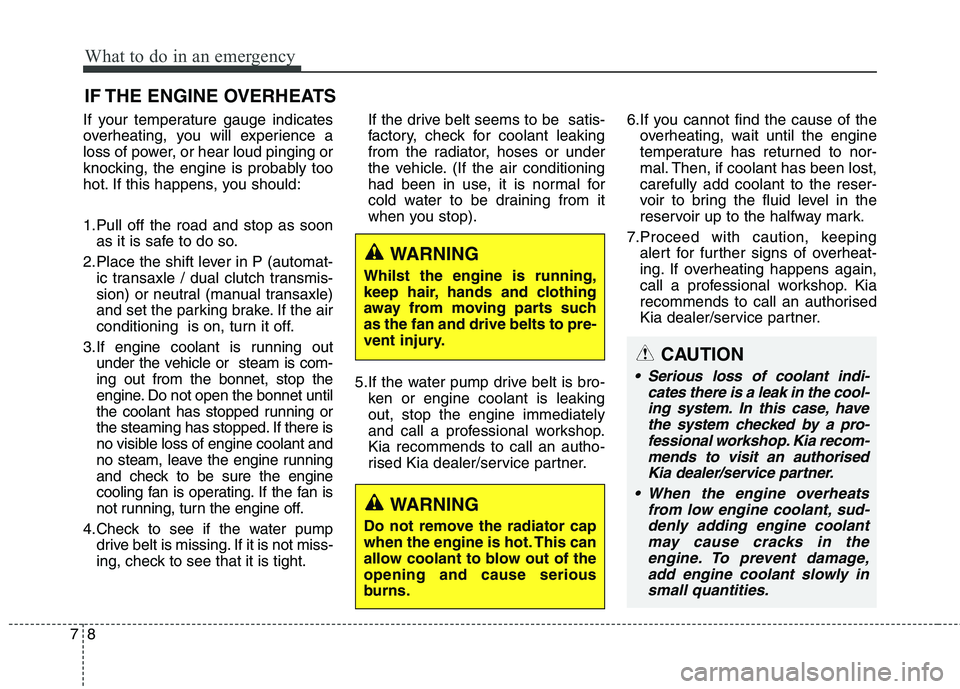
What to do in an emergency
8
7
IF THE ENGINE OVERHEATS
If your temperature gauge indicates
overheating, you will experience a
loss of power, or hear loud pinging or
knocking, the engine is probably too
hot. If this happens, you should:
1.Pull off the road and stop as soon as it is safe to do so.
2.Place the shift lever in P (automat- ic transaxle / dual clutch transmis-
sion) or neutral (manual transaxle)
and set the parking brake. If the air
conditioning is on, turn it off.
3.If engine coolant is running out under the vehicle or steam is com-ing out from the bonnet, stop the
engine. Do not open the bonnet until
the coolant has stopped running or
the steaming has stopped. If there is
no visible loss of engine coolant and
no steam, leave the engine running
and check to be sure the engine
cooling fan is operating. If the fan is
not running, turn the engine off.
4.Check to see if the water pump drive belt is missing. If it is not miss-
ing, check to see that it is tight. If the drive belt seems to be satis-
factory, check for coolant leaking
from the radiator, hoses or under
the vehicle. (If the air conditioning
had been in use, it is normal for
cold water to be draining from it
when you stop).
5.If the water pump drive belt is bro- ken or engine coolant is leakingout, stop the engine immediately
and call a professional workshop.Kia recommends to call an autho-
rised Kia dealer/service partner. 6.If you cannot find the cause of the
overheating, wait until the engine
temperature has returned to nor-
mal. Then, if coolant has been lost,carefully add coolant to the reser-
voir to bring the fluid level in the
reservoir up to the halfway mark.
7.Proceed with caution, keeping alert for further signs of overheat-
ing. If overheating happens again,
call a professional workshop. Kia
recommends to call an authorised
Kia dealer/service partner.
CAUTION
Serious loss of coolant indi-
cates there is a leak in the cool-ing system. In this case, have the system checked by a pro-fessional workshop. Kia recom-mends to visit an authorised Kia dealer/service partner.
When the engine overheats from low engine coolant, sud-denly adding engine coolantmay cause cracks in the engine. To prevent damage,add engine coolant slowly insmall quantities.
WARNING
Whilst the engine is running,
keep hair, hands and clothing
away from moving parts suchas the fan and drive belts to pre-
vent injury.
WARNING
Do not remove the radiator cap
when the engine is hot. This can
allow coolant to blow out of theopening and cause serious
burns.
Page 596 of 723
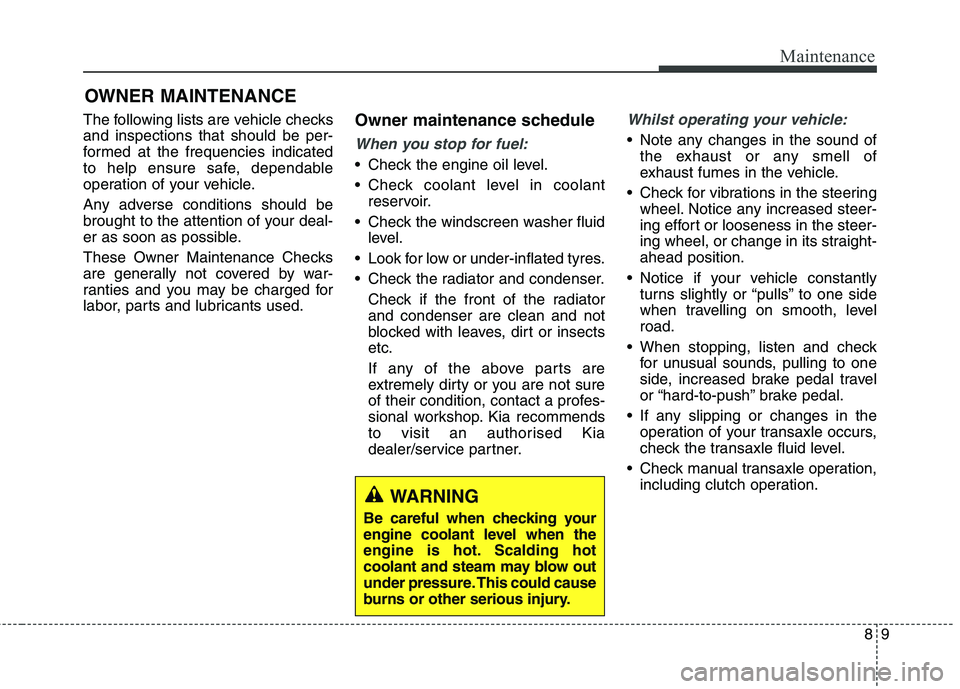
89
Maintenance
OWNER MAINTENANCE
The following lists are vehicle checks and inspections that should be per-
formed at the frequencies indicated
to help ensure safe, dependable
operation of your vehicle.
Any adverse conditions should be
brought to the attention of your deal-
er as soon as possible.
These Owner Maintenance Checks
are generally not covered by war-
ranties and you may be charged for
labor, parts and lubricants used. Owner maintenance schedule
When you stop for fuel:
Check the engine oil level.
Check coolant level in coolant
reservoir.
Check the windscreen washer fluid level.
Look for low or under-inflated tyres.
Check the radiator and condenser. Check if the front of the radiator and condenser are clean and not
blocked with leaves, dirt or insectsetc.
If any of the above parts are
extremely dirty or you are not sure
of their condition, contact a profes-
sional workshop. Kia recommends
to visit an authorised Kia
dealer/service partner.
Whilst operating your vehicle:
Note any changes in the sound ofthe exhaust or any smell of
exhaust fumes in the vehicle.
Check for vibrations in the steering wheel. Notice any increased steer-
ing effort or looseness in the steer-
ing wheel, or change in its straight-ahead position.
Notice if your vehicle constantly turns slightly or “pulls” to one side
when travelling on smooth, levelroad.
When stopping, listen and check for unusual sounds, pulling to one
side, increased brake pedal travel
or “hard-to-push” brake pedal.
If any slipping or changes in the operation of your transaxle occurs,
check the transaxle fluid level.
Check manual transaxle operation, including clutch operation.
WARNING
Be careful when checking your
engine coolant level when the
engine is hot. Scalding hot
coolant and steam may blow out
under pressure. This could cause
burns or other serious injury.
Page 597 of 723
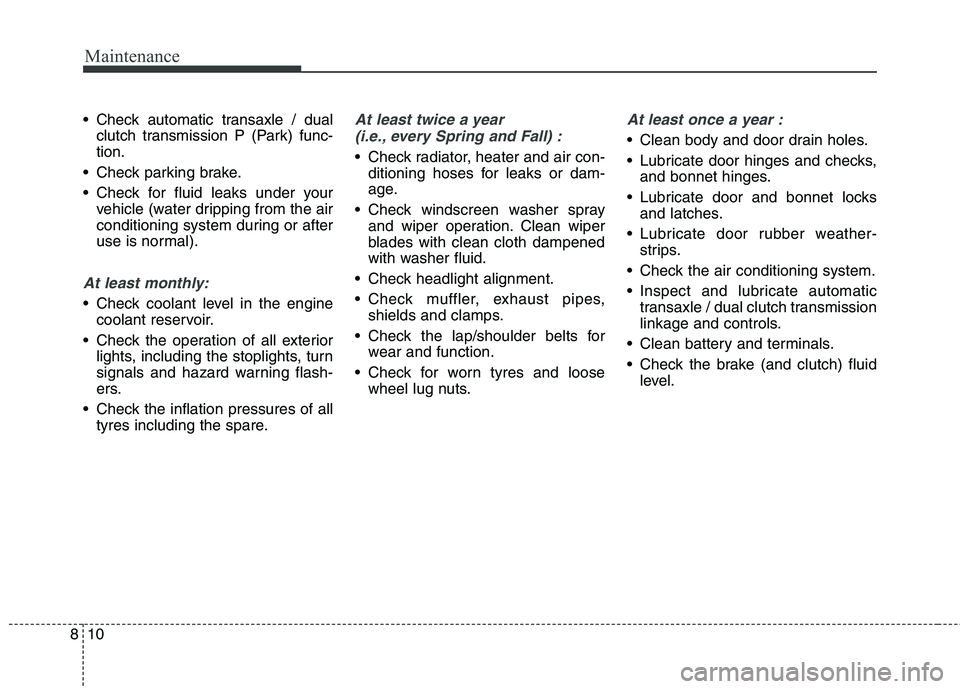
Maintenance
10
8
Check automatic transaxle / dual
clutch transmission P (Park) func- tion.
Check parking brake.
Check for fluid leaks under your vehicle (water dripping from the air
conditioning system during or after
use is normal).
At least monthly:
Check coolant level in the enginecoolant reservoir.
Check the operation of all exterior lights, including the stoplights, turn
signals and hazard warning flash-
ers.
Check the inflation pressures of all tyres including the spare.
At least twice a year
(i.e., every Spring and Fall) :
Check radiator, heater and air con- ditioning hoses for leaks or dam-
age.
Check windscreen washer spray and wiper operation. Clean wiper
blades with clean cloth dampened
with washer fluid.
Check headlight alignment.
Check muffler, exhaust pipes, shields and clamps.
Check the lap/shoulder belts for wear and function.
Check for worn tyres and loose wheel lug nuts.
At least once a year :
Clean body and door drain holes.
Lubricate door hinges and checks,and bonnet hinges.
Lubricate door and bonnet locks and latches.
Lubricate door rubber weather- strips.
Check the air conditioning system.
Inspect and lubricate automatic transaxle / dual clutch transmission
linkage and controls.
Clean battery and terminals.
Check the brake (and clutch) fluid level.
Page 599 of 723
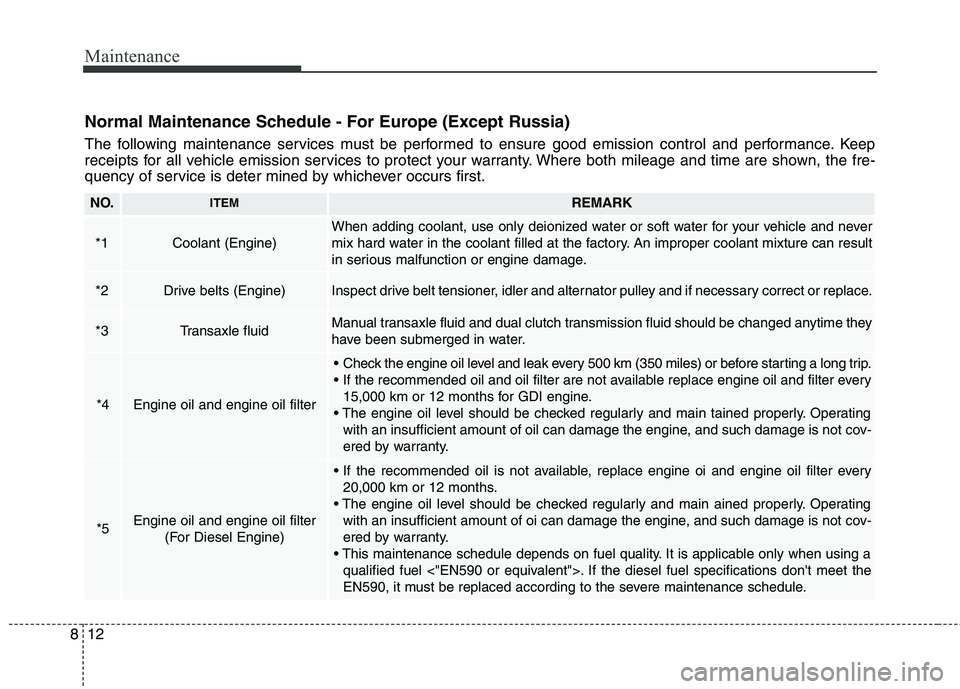
Maintenance
12
8
Normal Maintenance Schedule - For Europe (Except Russia)
The following maintenance services must be performed to ensure good emission control and performance. Keep
receipts for all vehicle emission services to protect your warranty. Where both mileage and time are shown, the fre-
quency of service is deter mined by whichever occurs first.
NO.ITEMREMARK
*1Coolant (Engine)
When adding coolant, use only deionized water or soft water for your vehicle and never
mix hard water in the coolant filled at the factory. An improper coolant mixture can result
in serious malfunction or engine damage.
*2Drive belts (Engine)Inspect drive belt tensioner, idler and alternator pulley and if necessary correct or replace.
*3Transaxle fluidManual transaxle fluid and dual clutch transmission fluid should be changed anytime they
have been submerged in water.
*4Engine oil and engine oil filter
Check the engine oil level and leak every 500 km (350 miles) or before starting a long trip.
15,000 km or 12 months for GDI engine.
Operating with an insufficient amount of oil can damage the engine, and such damage is not cov-
ered by warranty.
*5Engine oil and engine oil filter (For Diesel Engine)
20,000 km or 12 months.
Operating with an insufficient amount of oi can damage the engine, and such damage is not cov-
ered by warranty.
It is applicable only when using a qualified fuel <"EN590 or equivalent">. If the diesel fuel specifications don't meet the
EN590, it must be replaced according to the severe maintenance schedule.
Page 622 of 723
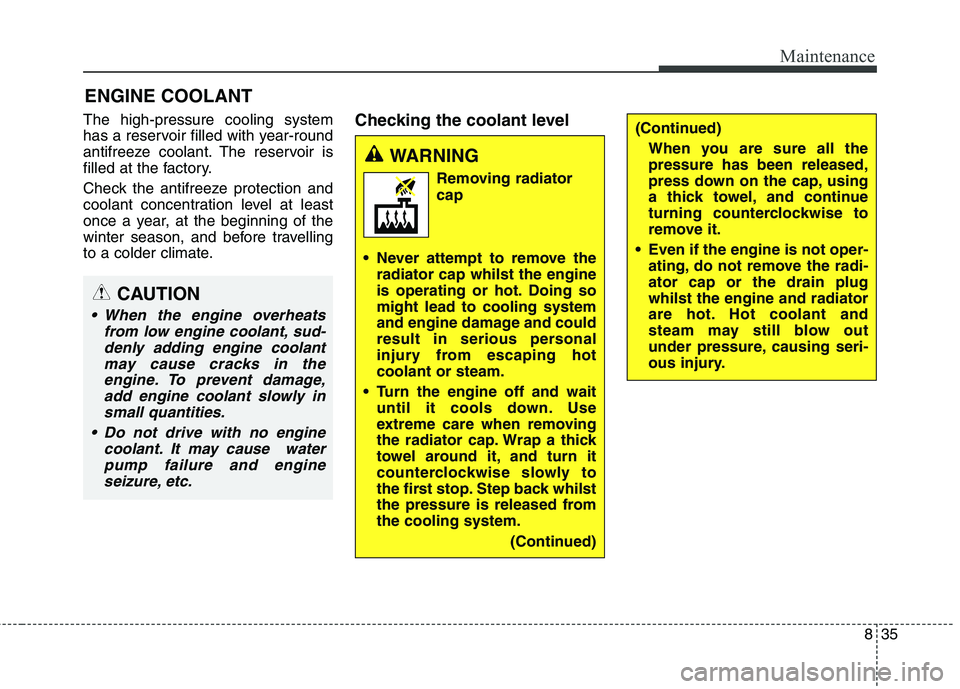
835
Maintenance
ENGINE COOLANT
The high-pressure cooling system
has a reservoir filled with year-round
antifreeze coolant. The reservoir is
filled at the factory.
Check the antifreeze protection and
coolant concentration level at least
once a year, at the beginning of the
winter season, and before travelling
to a colder climate. Checking the coolant level
(Continued)
When you are sure all the pressure has been released,
press down on the cap, using
a thick towel, and continue
turning counterclockwise to
remove it.
Even if the engine is not oper- ating, do not remove the radi-ator cap or the drain plugwhilst the engine and radiator
are hot. Hot coolant and
steam may still blow out
under pressure, causing seri-
ous injury.
WARNING
Removing radiatorcap
Never attempt to remove the radiator cap whilst the engine
is operating or hot. Doing somight lead to cooling system
and engine damage and could
result in serious personal
injury from escaping hotcoolant or steam.
Turn the engine off and wait until it cools down. Use
extreme care when removing
the radiator cap. Wrap a thick
towel around it, and turn it
counterclockwise slowly to
the first stop. Step back whilst
the pressure is released fromthe cooling system.
(Continued)
CAUTION
When the engine overheatsfrom low engine coolant, sud-denly adding engine coolantmay cause cracks in theengine. To prevent damage, add engine coolant slowly insmall quantities.
Do not drive with no engine coolant. It may cause waterpump failure and engine seizure, etc.
Page 623 of 723
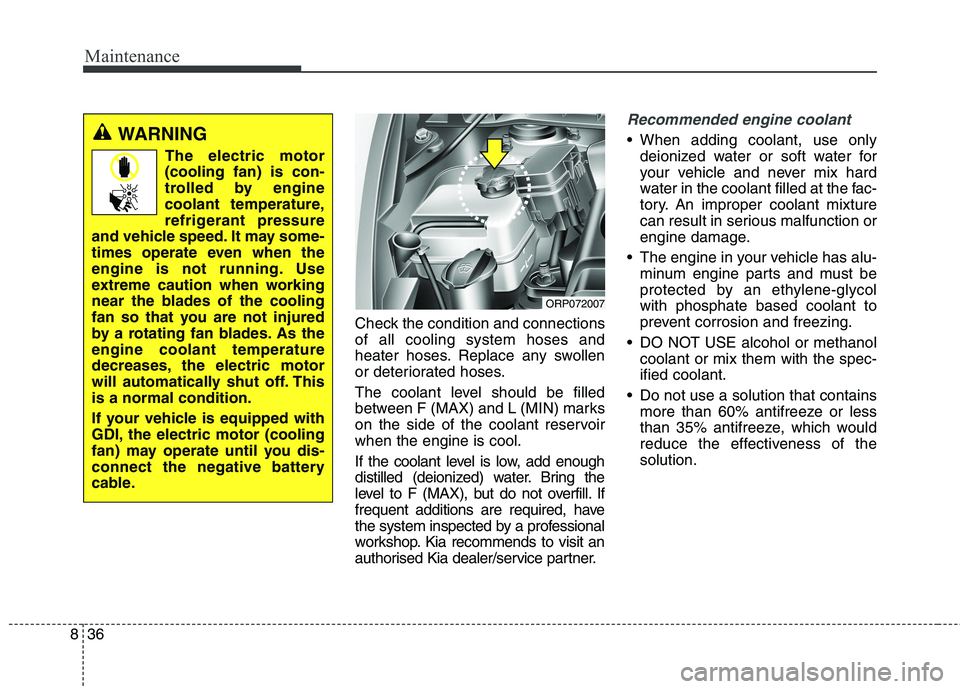
Maintenance
36
8
Check the condition and connections of all cooling system hoses and
heater hoses. Replace any swollen
or deteriorated hoses.
The coolant level should be filled
between F (MAX) and L (MIN) marks
on the side of the coolant reservoirwhen the engine is cool.
If the coolant level is low, add enough
distilled (deionized) water. Bring the
level to F (MAX), but do not overfill. If
frequent additions are required, have
the system inspected by a professional
workshop. Kia recommends to visit an
authorised Kia dealer/service partner.
Recommended engine coolant
When adding coolant, use only
deionized water or soft water for
your vehicle and never mix hard
water in the coolant filled at the fac-
tory. An improper coolant mixture
can result in serious malfunction or
engine damage.
The engine in your vehicle has alu- minum engine parts and must be
protected by an ethylene-glycolwith phosphate based coolant to
prevent corrosion and freezing.
DO NOT USE alcohol or methanol coolant or mix them with the spec-ified coolant.
Do not use a solution that contains more than 60% antifreeze or less
than 35% antifreeze, which would
reduce the effectiveness of thesolution.WARNING
The electric motor
(cooling fan) is con-
trolled by engine
coolant temperature,
refrigerant pressure
and vehicle speed. It may some-
times operate even when the
engine is not running. Use
extreme caution when working
near the blades of the cooling
fan so that you are not injured
by a rotating fan blades. As theengine coolant temperature
decreases, the electric motor
will automatically shut off. Thisis a normal condition.
If your vehicle is equipped with
GDI, the electric motor (cooling
fan) may operate until you dis-
connect the negative battery
cable.
ORP072007
Page 626 of 723
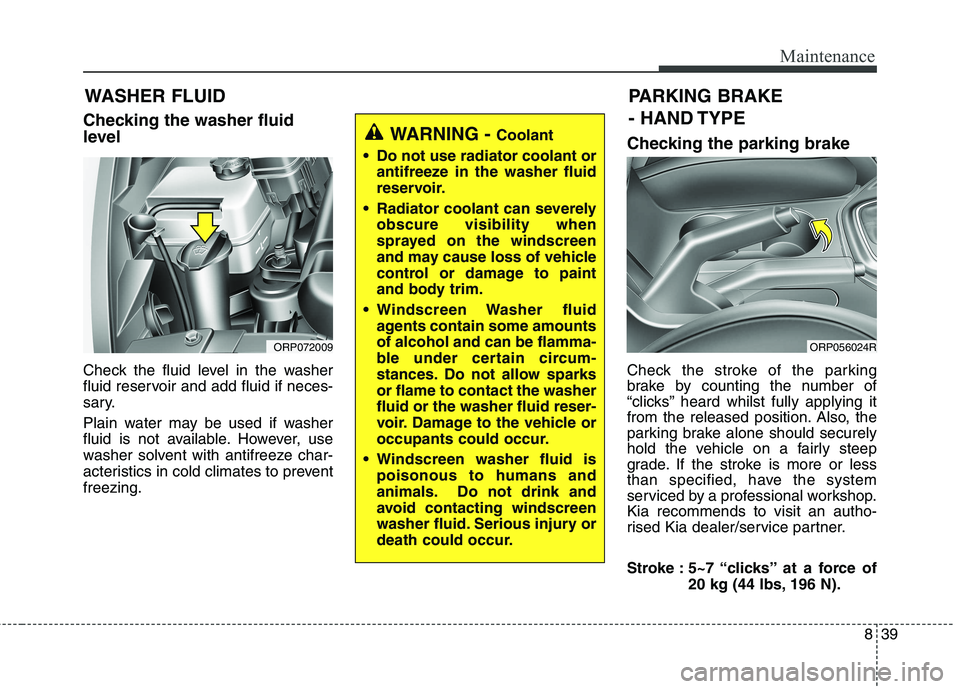
839
Maintenance
WASHER FLUID
Checking the washer fluid
level
Check the fluid level in the washer
fluid reservoir and add fluid if neces-
sary.
Plain water may be used if washer
fluid is not available. However, use
washer solvent with antifreeze char-
acteristics in cold climates to preventfreezing. Checking the parking brake
Check the stroke of the parking
brake by counting the number of
“clicks’’ heard whilst fully applying it
from the released position. Also, the
parking brake alone should securely
hold the vehicle on a fairly steep
grade. If the stroke is more or less
than specified, have the system
serviced by a professional workshop.Kia recommends to visit an autho-
rised Kia dealer/service partner.
Stroke : 5~7 “clicks’’ at a force of
20 kg (44 lbs, 196 N).
ORP072009
WARNING - Coolant
Do not use radiator coolant or antifreeze in the washer fluid
reservoir.
Radiator coolant can severely obscure visibility when
sprayed on the windscreen
and may cause loss of vehicle
control or damage to paint
and body trim.
Windscreen Washer fluid agents contain some amountsof alcohol and can be flamma-
ble under certain circum-
stances. Do not allow sparksor flame to contact the washerfluid or the washer fluid reser-
voir. Damage to the vehicle or
occupants could occur.
Windscreen washer fluid is poisonous to humans and
animals. Do not drink and
avoid contacting windscreen
washer fluid. Serious injury or
death could occur.
PARKING BRAKE
- HAND TYPE
ORP056024R
Page 716 of 723
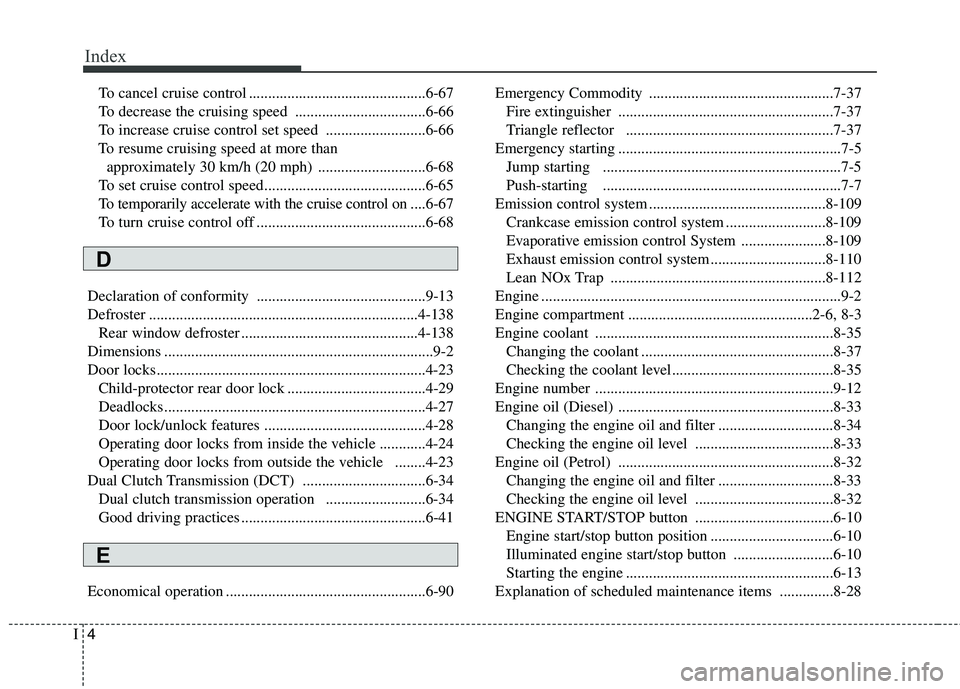
Index
4
I
To cancel cruise control ..............................................6-67
To decrease the cruising speed ..................................6-66
To increase cruise control set speed ..........................6-66
To resume cruising speed at more than approximately 30 km/h (20 mph) ............................6-68
To set cruise control speed..........................................6-65
To temporarily accelerate with the cruise control on ....6-67
To turn cruise control off ............................................6-68
Declaration of conformity ............................................9-13
Defroster ......................................................................4-138 Rear window defroster ..............................................4-138
Dimensions ......................................................................9-2
Door locks......................................................................4-23 Child-protector rear door lock ....................................4-29
Deadlocks....................................................................4-27
Door lock/unlock features ..........................................4-28
Operating door locks from inside the vehicle ............4-24
Operating door locks from outside the vehicle ........4-23
Dual Clutch Transmission (DCT) ................................6-34 Dual clutch transmission operation ..........................6-34
Good driving practices ................................................6-41
Economical operation ....................................................6-90 Emergency Commodity ................................................7-37
Fire extinguisher ........................................................7-37
Triangle reflector ......................................................7-37
Emergency starting ..........................................................7-5 Jump starting ..............................................................7-5
Push-starting ..............................................................7-7
Emission control system ..............................................8-109 Crankcase emission control system ..........................8-109
Evaporative emission control System ......................8-109
Exhaust emission control system ..............................8-110
Lean NOx Trap ........................................................8-112
Engine ..............................................................................9-2
Engine compartment ................................................2-6, 8-3
Engine coolant ..............................................................8-35 Changing the coolant ..................................................8-37
Checking the coolant level..........................................8-35
Engine number ..............................................................9-12
Engine oil (Diesel) ........................................................8-33 Changing the engine oil and filter ..............................8-34
Checking the engine oil level ....................................8-33
Engine oil (Petrol) ........................................................8-32 Changing the engine oil and filter ..............................8-33
Checking the engine oil level ....................................8-32
ENGINE START/STOP button ....................................6-10 Engine start/stop button position ................................6-10
Illuminated engine start/stop button ..........................6-10
Starting the engine ......................................................6-13
Explanation of scheduled maintenance items ..............8-28
D
E